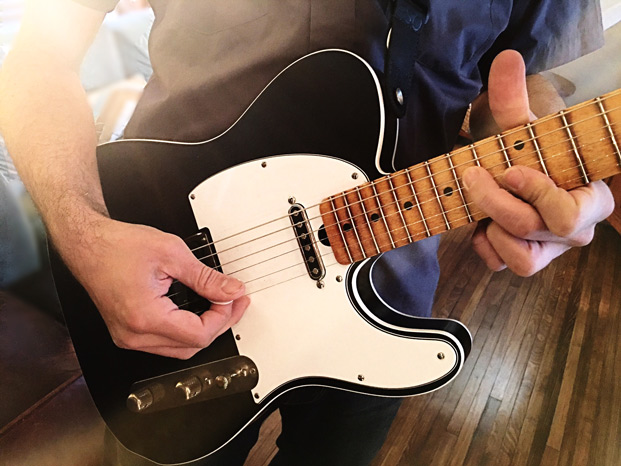Soloing with the Mixed Blues Scale
This cool-sounding scale can jazz up your blues solos in no time. Give it a try!

Learning to play the blues in a jazzy style means stepping outside the minor blues scale and exploring other melodic options in your solos.
But you don’t need to go very far to find a cool-sounding scale that can jazz up your blues solos in no time.
In today’s lesson, we’ll be looking into the mixed blues scale, which combines the notes from the minor and major blues scales to outline the underlying blues chord changes, while retaining a healthy dose of the blues at the same time.
Major and Minor Blues Scales
To begin, here's a quick review of the minor and major blues scales, written over an A7 chord in the example below. The minor blues scale contains the notes R-b3-4-#4-5-b7, and the major blues scale contains the notes R-2-b3-3-5-6, so they share a few notes and have a few different notes between them.
The notes they share are the root, b3 and 5th, while the other notes are different between the two scales; minor blues has the 4, #4 and b7; while the major blues scale has 2, 3 and 6.
Try playing both of these scales back to back over an A7 chord, with a backing track if possible, in order to hear how they both sound when applied to a chord such as A7.
Mixed Blues Scale
Now that you've looked at both of these scales separately, we’re going to combine the major and minor blues scales in order to build what I like to call the mixed blues scale.

This scale contains all of the notes from both scales, R-2-b3-3-4-#4-5-6-b7, and has a sound that outlines the chord, since it has the R-3-5-b7 arpeggio built into it, and remains bluesy with the b3 and #4 at the same time. While you could play all of these notes in order, as I wrote out in the previous paragraph, you’ll see in the example below that I leave out certain notes along the way, notes that get added in later in the scale.
This is mostly due to the fact that many famous players who use this scale tend to use certain notes in specific octaves, so I’ve written it out in that way to get you into that style quickly and accurately when adding this scale to your soloing repertoire.
Try putting on an A7 backing track and play up and down this scale to hear how it sounds over that chord, and then begin to improvise over an A7 harmony using only the A mixed blues scale as the basis for your lines to hear how it sounds in a soloing situation.

Mixed Blues Scale Lick
Lastly, here’s an example of a lick over A7 built with the notes from the A mixed blues scale. Since this scale contains the notes of the A7 arpeggio, you need to treat it more like an arpeggio than a blues scale, meaning that if you have an A7 chord, you play the A mixed blues scale. If you have a D7 chord, you play a D7 mixed blues scale and so on.
Try this lick out and see how it sounds over an A7 chord, before transposing it to other keys, adding it to your solo vocabulary and writing/learning a number of mixed blues scale licks of your own as you explore this concept further in the woodshed.
Matt Warnock is the owner of mattwarnockguitar.com, a free website that provides hundreds of lessons and resources designed to help guitarists of all experience levels meet their practice and performance goals. Matt lives in the UK, where he is a lecturer in Popular Music Performance at the University of Chester and an examiner for the London College of Music (Registry of Guitar Tutors).
Get The Pick Newsletter
All the latest guitar news, interviews, lessons, reviews, deals and more, direct to your inbox!
Matt Warnock is the owner of mattwarnockguitar.com, a free website that provides hundreds of lessons and resources designed to help guitarists of all experience levels meet their practice and performance goals. Matt lives in the UK, where he teaches Skype guitar students all over the world, and is an examiner for the London College of Music (Registry of Guitar Tutors).
“There are so many sounds to be discovered when you get away from using a pick”: Jared James Nichols shows you how to add “snap, crackle and pop” to your playing with banjo rolls and string snaps
Don't let chord inversions bamboozle you. It's simply the case of shuffling the notes around







![Joe Bonamassa [left] wears a deep blue suit and polka-dotted shirt and plays his green refin Strat; the late Irish blues legend Rory Gallagher [right] screams and inflicts some punishment on his heavily worn number one Stratocaster.](https://cdn.mos.cms.futurecdn.net/cw28h7UBcTVfTLs7p7eiLe.jpg)


